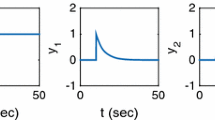Abstract
Suspensions of chemotactic bacteria develop spatial and temporal structures in response to an initial inhomogeneity in the medium. A theoretical model is presented for the analysis of spatial and temporal evolution of bacterial bands in response to several attractants. Applications of the model to various experimental cases give good agreement between theory and observation. The theoretical analysis provides further insight to the mechanisms governing band formation and band migration.
Similar content being viewed by others
Literature
Adler, J. 1966. “Chemotaxis in Bacteria.”Science 153, 708–716.
Berg, H. C. 1971. “How to Track Bacteria.”Rev. scient. Instrum. 42, 868–871.
— 1975. “Chemotaxis in Bacteria.”A. Rev. Biophys. Bioengng 4, 119–136.
— and E. M. Purcell. 1977. “Physics of Chemoreception.”Biophys. J. 20, 193–219.
Boon, J. P. 1975. “Theoretical Models for Bacterial Motion and Chemotaxis.” InMembranes, Dissipative Structures and Evolution (Eds G. Nicolis and R. Lefever), pp. 169–190. New York: Wiley Interscience.
— 1983. “Motility of Living Cells and Micro-organisms.” InThe Application of Laser Light Scattering to the Study of Biological Motion (Eds J. C. Earnshaw and M. W. Steer), pp. 561–601. New York: Plenum Press.
— 1984. “Model for Approaching Colonies.”J. theor. Biol. 110, 501–503.
Carlson, F. D. 1962. “A Theory of the Survival Value of Motility.” InSpermatozoon Motility, pp. 137–146. Washington: AAAS.
Chen, S. H. and F. R. Hallett. 1982. “Determination of Motile Behavior of Prokayotic and Eukaryotic Cells by Quasi-elastic Light Scattering.”Q. Rev. Biophys. 15, 131–222.
Childress, S. and J. K. Percus. 1981. “Nonlinear Aspects of Chemotaxis.”Mathl Biosci. 56, 217–237.
Dahlquist, F. W., P. S. Lovely and D. E. Koshland Jr. 1972. “Quantitive Analysis of Bacterial Migration in Chemotaxis.”Nature New Biol. 236, 120–123.
Engelman, T. W. 1881. “Neue Methode zur Untersuchung der Sauerstoffausschleidung Pflanzlicher und Thierischer Organismen.”Pflugers Arch. ges. Physiol. 25, 285–292.
Herpigny, B. 1983. “Spectroscopie par Diffusion de la lumière: Changements Conformationnels des Protéines, Chimiotaxie et Motilité Bactérienne.” Ph.D. Thesis, Brussels.
Herpigny, B., J. P. Boon and R. Lavalle. “Bacterial Chemotaxis and Band Formation: Response to the Simultaneous Effects of two Attractants.” (To be published.)
Jäger, W. and J. D. Muray (Eds.). 1984Modeling of Patterns in Space and Time, Lecture Notes in Biomathematics, Vol. 55. Berlin: Springer-Verlag.
Keller, E. F. and L. A. Segel. 1970. “Initiation of Slime Mold Aggregation Viewed as an Instability.”J. theor. Biol. 26, 399–415.
— and —. 1971. “Traveling Bands of Chemotactic Bacteria: A Theoretical Analysis.”J. theor. Biol. 30, 235–248.
Koshland, D. E. Jr. 1980.Bacterial Chemotaxis as a Model Behavioral System. New York: Raven Press.
Lapidus, I. R. and M. Levandowsky. 1981. “Mathematical Models of Behavioral Responses to Sensory Stimuli by Protozoa.” InBiochemistry and Physiology of Protozoa, Vol. 4, pp. 235–260. New York: Academic Press.
— and R. Schiller. 1974. “A Mathematical Model for Bacterial Chemotaxis.”Biophys. J. 14, 825–834.
— and —. 1975. “Bacterial Chemotaxis in a Fixed Attractant Gradient.”J. theor. Biol. 53, 215–222.
— and —. 1976. “Model for the Chemotactic Response of a Bacterial Population.”Biophys. J. 16, 779–789.
Lauffenburger, D. A. and B. Calgano. 1983. “Competition between Two Microbial Populations in a Non-mixed Environment: Effect of Cell Random Motility.”Biotech. Bioengng 25, 69–89.
—, M. Grady and K. H. Keller. 1984. “An Hypothesis for Approaching Swarms of Myxobacteria.”J. theor. Biol. 110, 257–274.
Lin, C. C. and L. A. Segel. 1974.Mathematics Applied to Deterministic Problems in the Natural Sciences, Chap. 10. New York: McMillan.
Lovely, P. S. and F. W. Dahlquist. 1975. “Statistical Measures of Bacterial Motility and Chemotaxis.”J. theor. Biol. 50, 477–496.
MacNab, R. M. and D. E. Koshland Jr. 1972. “The Gradient-sensing Mechanism in Bacterial Chemotaxis.”Proc. natn. Acad. Sci. U.S.A. 69, 2509–2512.
Mahler, H. R. and E. H. Cordes. 1966.Biological Chemistry, Chap. 6. New York: Harper.
Mesibov, R., G. W. Ordal and J. Adler. 1973. “The Range of Attractant Concentrations for Bacterial Chemotaxis and the Threshold and Size of Response over this Range: Weber Law and Related Phenomena.”J. gen. Physiol. 62, 203–223.
Nicolis, G. and I. Prigogine. 1977.Self-organization in Nonequilibrium Systems. New York: Wiley Interscience.
Nossal, R. 1972. “Boundary Movement of Chemotactic Bacterial Populations.”Mathl. Biosci. 13, 397–405.
— 1980. “Mathematical Theories of Topotaxis.” InBiological Growth and Spread (Eds W. Jäger, M. Rost and P. Tautu), pp. 410–439, Berlin: Springer-Verlag.
— and C. H. Weiss. 1973. “Analysis of Densitometry Assay for Bacterial Chemotaxis.”J. Theor. Biol. 41, 143–147.
Pfeffer, W. 1983. “Locomotorische Richtungsbewegungen durch Chemische Reize.”Ber. Dtsch. Bot. Ges. 1, 524–533.
Purcell, E. M. 1976. “Life at Low Reynolds Number.” InPhysics and our World (Ed. Huang). pp. 49–64. New York: AIP.
Rosen, G. 1974. “On the Propagation Theory for Bands of Chemotactic Bacteria.”Mathl Biosci. 20, 185–189.
—, 1975a. “Analytical Solution of the Initial-value Problem for Traveling Bands of Chemotactic Bacteria.”J. theor. Biol. 49, 311–321.
— 1975b. “On the Stability of Steadily Propagating Bands of Chemotactic Bacteria.”Mathl Biosci. 24, 273–279.
—. 1980. “Propagation Theory for Bands of Chemotactic Bacteria.”Mathl Biosci. 52, 303–309.
Segel, L. A. 1978. “Mathematical Models for Cellular Behavior.” InStudies in Mathematical Biology (Ed. S. A. Levin), Vol. 15, part 1, pp. 156–190. Washington: The Mathematical Association of America.
— and J. L. Jackson. 1973. “Theoretical Analysis of Chemotactic Movement in Bacteria.”J. mechanochem. Cell Motility 2, 25.
Tsang, N., R. M. MacNab and D. E. Koshland, Jr. 1973, “Common Mechanism for Repellents and Attactants in Bacterial Chemotaxis.”Science 181, 60–63.
Wang, P. C. 1982. “A Study of Bacterial Motion and Chemotactic Bands by Laser Light Scattering.” Ph.D. thesis, Massachusetts Institute of Technology.
Author information
Authors and Affiliations
Rights and permissions
About this article
Cite this article
Boon, JP., Herpigny, B. Model for chemotactic bacterial bands. Bltn Mathcal Biology 48, 1–19 (1986). https://doi.org/10.1007/BF02460059
Received:
Revised:
Issue Date:
DOI: https://doi.org/10.1007/BF02460059




